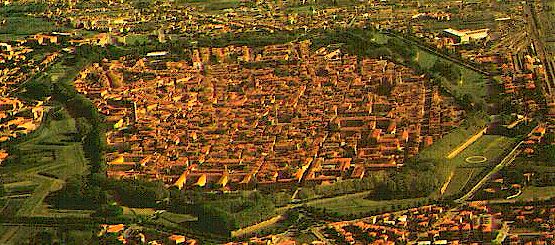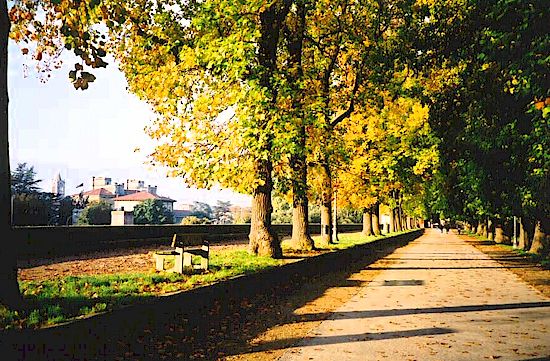
Aerial view of Lucca, Italy, showing the intact, massive city wall, now lined with trees
and traversed by an extremely agreeable footpath.
|
|
|

Aerial view of Lucca, Italy,
showing the intact, massive city wall, now lined with trees
and traversed by an extremely agreeable footpath.
Vacation accommodations and hotels in Lucca.

Main sights of Lucca, ItalyDuomo of San MartinoThe cathedral of Lucca, the Duomo of San Martino, which dates back to the 6 C, was rebuilt in Romanesque style in the 11 C, consecrated by Alexander II (1070), and again restored in the quattrocento, when the beautiful columns of the upper arches were added. Church of San Frediano, LuccaSan Frediano is the only example of Lombard architecture preserved without notable alteration, excepting the façade, which is of the year 1200. S. Maria foris Portam, S. Michele, S. Romano, and the other churches all possess valuable works of art. The tomb of the Lucchese poet, Guidiccioni, is in the church of S. Francesco (quattrocento). Lucca Palazzo PubblicoThe Palazzo Pubblico, formerly the ducal palace, was begun by Ammanati in 1578, continued by Pini in 1729, and further enlarged by Prince Bacciochi in the 19 C. Adjoining are the library. It houses many valuable manuscripts and a picture gallery. Manzi Palace The Manzi palace contains a collection of paintings.
|
||||
|
||||
Ponte Colandi at Fabbriche di Vallico, Province of LuccaThe Colandi bridge at Fabbriche di Vallico is a must see for anyone interested in the architectural curiosities of Tuscany. It is in fact a customs post located on the former frontier of the Province of Lucca. In order to cross the river and proceed south, merchants and carries coming from the north were obliged to use this bridge and to pass through the customs post. There is even a cell, still extant, where anyone refusing to pay customs duty would be incarcerated. More about the Ponte Colandi customs bridge. |
||||
Ponte della Maddalena (Ponte del Diavolo), near Borgo a Mozzano in the Province of LuccaThe beautiful and intriguing Ponte della Maddalena is a bridge crossing the Serchio river near the town of Borgo a Mozzano in the province of Lucca, located some 24 km north of Lucca and 5 km from Bagni di Lucca. The interesting Ponte Colandi at Fabbriche di Vallico is also nearby and can be included in a tour of the Serchio river valley. More about the Ponte della Maddalena bridge. |
||||
|
Montecatini Terme, 30 km east of Lucca, is a wealthy and popular summer resort located at the foot of the Pistoian mountains. The baths and spas date back to the fourteenth century and nowadays there are nine fully-functioning 'terme' spread around the town. There are many extremely attractive golf courses within easy reach. |
History of Lucca, ItalyTuscany was originally inhabited by tribes of Ligurians and by the Etruscans. Lucca was a city of the Ligurians. When the Romans arrived, they allied themselves with the Etruscans against the Ligurians who fled into the Apuan Alps. Lucca is first mentioned in 218 B.C., when the Roman general Sempronius regrouped here after an unsuccessful battle with Hannibal. In 177 B.C., a Roman colony was established and in 56 B.C. Cæsar, Pompey and Crassus renewed the triumvirate at Lucca. The main streets of the city were the "cardo maximo" which ran in a north-southerly direction corresponding to the modern Via Fillungo, and the "decumano maximo" corresponding to the modern Via S. Croce, which ran in a east-westerly direction.
Lucca in the Dark AgesDuring the Gothic wars, Lucca was besieged and taken by Totila (550). Hoping for assistance from the Franks, the Lucchesi obstinately resisted the attack of Narses, surrendering only after a siege of seven months (553). Lucca later fell into the hands of the Lombards, becoming a place of great importance and the favourite seat of the Marquesses of Tuscany. In 981 Otto bestowed on its bishop civil jurisdiction over the entire diocesan territory but in 1081 Henry IV made it a free city and conferred other favours upon it, especially in the way of trade. This was the origin of the Republic of Lucca, which lasted until 1799. Lucca in the Middles AgesFrom 1088 to 1144, Lucca was continually at war with her rival Pisa, and either by conquest or purchase increased her possessions. In 1160 the Guelph marquess finally surrendered all right of jurisdiction. Lucca was generally on the side of the pope against the emperor, and hence joined the League of S. Ginesio (1197). In the thirteenth century, despite her wars with Pisa, Florence, and the imperial cities, Lucca increased her power and commerce, but in 1313 the city was taken by Uguccione della Faggiuola, Lord of Pisa. The Lucchesi, however, under the most dramatic circumstances, freed themselves and chose as captain their fellow-citizen, Castruccio degli Antelminelli, known as Castracane (1316), the restorer of the military art, who had been imprisoned by Uguccione. Castruccio drove out the Pisans, obtained for life the title of Defender of the People, and received from Louis the Bavarian the hereditary title of Duke of Lucca. His descendants, however, were deprived of the title by the same prince (1328-9). Castruccio adorned and fortified the city whose territory now extended from the Magra to Pistoia and Volterra. Lucca during the RenaissanceOn the death of Castruccio, Louis conferred Lucca on Francesco, a relative and enemy of Castruccio. The Lucchesi, however, placed themselves under John of Bohemia; the latter, in 1333, pawned the city to the Rossi of Parma, who ceded it to Mastino della Scala (1335), by whom it was sold to the Florentines for 100,000 florins (1341). This displeased the Pisans, who occupied the city (1342). It was liberated by Charles IV (1360), who gave it an imperial vicar. From 1370 it was free. In 1400 Paolo Guinigi obtained the chief power, which he exercised with moderation and justice. At the instigation of the Florentines, who sought possession of the city, Guinigi was betrayed into the hands of Filippo Maria Visconti (1430), who caused him to be murdered at Pavia. With the aid of Piccinino, Lucca maintained her freedom against the Florentines. After that the security of this little state, governed by the people, was undisturbed. The revolt of the straccioni discolato deserves mention. It was similar to the ostracism of the Athenians. If a citizen, either through wealth or merit, obtained excessive favour among the people, twenty-five signatures were sufficient to banish him. Lucca, Italy, in Modern TimesIn 1799 Lucca was joined to the Cisalpine Republic. In 1805 Napoleon made it a dukedom for his cousin Felice Bacciochi. In 1814 it was occupied by the Neapolitans, and later by the Austrians. In 1817 it was given to Maria Luisa, widow of the King of Etruria, whose son Carlo Ludovico ceded it to Tuscany in 1847. Lucca is now the capital of the province of the same name in Tuscany, central Italy, and is situated on the River Serchio at the base of the Tuscan Apennines in the midst of a well-watered, fertile plain, close to the Mediterranean Sea. Its olive oil is exceptionally good although not as good as that produced by your webmaster, of course. The Garfagnana ranges behind Lucca |
Pictures
and descriptions of famous gardens at villas
located in the Chianti, Italy and Tuscany countryside.
Lucca Tourist Information ©ammonet Infotech 2001 - 2021. All rights reserved.